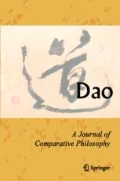Abstract
This article offers a study of the early formation and development of the ideal of harmony in ancient Chinese philosophy and ancient Greek philosophy. It shows that, unlike the Pythagorean notion of harmony, which is primarily based on a linear progressive model with a pre-set order, the ancient Chinese concept of harmony is best understood as a comprehensive process of harmonization. It encompasses spatial as well as temporal dimensions, metaphysical as well as moral and aesthetical dimensions. It is a fundamentally open notion in the sense that it does not aim to conform to any pre-set order. This broader, richer, and more liberal understanding of harmony has had a profound influence on Chinese culture as whole in its long history.
Similar content being viewed by others
References
Analects 論語. In the Thirteen Classics with Commentaries.
Annotated Shuo Wen Jie Zi 說文解字注. Shanghai 上海: Shanghai Shudian 上海書店. 1992.
Burnet, J. 1968. Greek Philosophy: Thales to Plato. New York: St. Martin’s Press.
Cai, Zong-qi 2002. Configurations of Comparative Poetics: Three Perspectives on Western and Chinese Literary Criticism. Honolulu: University of Hawai‘i Press.
Chen, Guying 陳鼓應. 1984. An Annotation, Interpretation, and Commentary of the Laozi 老子今註今譯及評介. Beijing 北京: Zhonghua Shuju 中華書局.
Cherniss, H. F. 1965. “The Relation of the Timaeus to Plato’s Later Dialogues.” In Studies in Plato’s Metaphysics. Edited by R. E. Allen. London and New York: Routledge and Kegan Paul.
Chun Qiu Zuo Zhuan 春秋左傳. In the Thirteen Classics with Commentaries.
Cook, S. 1995. Unity and Diversity in the Musical Thought of Warring States China. Ph. D. Dissertation, Department of Asian Languages and Cultures, University of Michigan.
Cornford, F. M. 1922. “Mysticism and Science in the Pythagorean Tradition.” Classical Quarterly 16.2: 137–150.
______. 1945. The Republic of Plato. Translated with introduction and notes. London: Oxford University Press.
______. 1950. The Unwritten Philosophy and Other Essays. Edited with an introductory memoir by W.K.C. Guthrie. Cambridge: Cambridge University Press.
Dao De Jing 道德經. In the Twenty-two Masters.
Dong, Chuping 董楚平 2002. “Exploring the Chinese Early Ancient Genesis Myths 中國上古創世神話鉤沉.” China Social Sciences 中國社會科學 5: 151–163.
Fang, Shuxin 方述鑫 1993. A Dictionary of Chinese Characters in Oracle Bones and Bronze Scripts 甲骨金文字典. Chengdu 成都: Bashu Shushe 巴蜀書社.
Franklin, J. C. 2002. “Harmony in Greek and Indo-Iranian Cosmology.” The Journal of Indo-European Studies 30(1–2): 1–25.
Freeman, K. 1983. Ancilla to the Pre-Socratic Philosophers: A Complete Translation of the Fragments in Diels,, Fragmente der Vorsokratiker. Cambridge, Mass.: Harvard University Press.
Girardot, N. J. 1984. Myth and Meaning in Early Taoism: The Theme of Chaos (hun-tun). Berkeley, Los Angeles, London: University of California Press.
Goold, G. P. 1977. Lowb Classical Library: Plato II (No. 165). Cambridge, Mass.: Harvard University Press.
Guo, Moruo 郭沫若 2002. Complete Works of Guo Moruo 郭沫若全集, vol. 1. Beijing 北京: Kexue Chubanshe 科學出版社.
Guthrie, W. K. C. 1962. A History of Greek Philosophy, vol. I. Cambridge: Cambridge University Press.
Huang, Xiangpeng 黃翔鵬 1979. “A Glorious Innovation of the pre-Qin Musical Culture 先秦音樂文化的光輝創造─曾侯乙墓的古樂器.” Wen Wu 文物: 278(7): 32–39.
Ji, Xusheng et al. 季旭昇, (eds) 2000. Collection of Bronze Scripts 金文總集. Taipei 臺北: Yiwen Yingshuguan 藝文印書館.
Jinzhou City Museum 荆州市博物舘 1998. The Chu Tomb Bamboo Strips from Guodian 郭店楚墓竹簡. Beijing 北京: Wenwu Chubanshe 文物出版社.
Lai, Kehong 來可弘 2000. The Guoyu Interpreted 國語直解. Shanghai 上海: Fudan 复旦 University Press.
Li, Chenyang 1999. The Tao Encounters the West: Explorations of Comparative Philosophy. Albany: The State University of New York.
______. 2004. “Zhongyong as Grand Harmony—An Alternative Reading to Ames and Hall’s Focusing the Familiar.” Dao: Journal of Comparative Philosophy. 3(2): 173–188.
______. 2006. “The Confucian Ideal of Harmony.” Philosophy East & West 56(4): 583–603.
Liu, Xinglong 劉興隆 1993. A New Dictionary of Oracle Bone Characters 新编甲骨文字典. Beijing 北京: Guoji Wenhua Chubanshe 國際文化出版社.
Liu, Zhao 劉釗. 2003. Annotated Guodian Chu Bamboo Texts 郭店楚简校釋. Fuzhou 福州: Fujian Renmin Chubanshe Press 人民出版社.
Ma, Chengyuan. 馬承源, (ed) 1990. Selection of Bronze Scripts of the Shang and Zhou Periods 商周青銅器銘文選, volume 4. Beijing 北京: Wenwu Chubanshe 文物出版社.
McKeon, R., ed. 1947. Introduction to Aristotle. New York: the Modern Library.
Mozi 墨子. In the Twenty-two Masters.
Owen, G. E. L. 1965, “The Place of the Timaeus in Plato’s Dialogues.” In Studies in Plato’s Metaphysics. Edited by R. E. Allen. London and New York: Routledge and Kegan Paul.
Palace Museum 故宫博物院. 1999. Bronzes in the Palace Museum 故宫青銅器. Beijing 北京: Zhijincheng Chubanshe 紫禁城出版社.
Rao, Zongyi 饒宗頤, Zeng Tongxian 曾憲通, (eds) 1985. Chu Silk Manuscript 楚帛書. Hong Kong: Zhonghua Shuju 中華書局.
Rawls, J. 1971. A Theory of Justice. Cambridge, Mass.: Harvard University Press.
Robin, L. 1928. Greek Thought and the Origin of the Scientific Spirit. New York: Russell & Russell.
Shi Jing 詩經. In the Thirteen Classics with Commentaries.
Thirteen Classics with Commentaries 十三經注疏, 1985. Beijing 北京: Zhongguo Shudian 中國書店.
Twenty-two Masters 二 十 二 子, 1986. Shanghai 上海: Shanghai Guji Chubanshe 上海古籍出版社.
Wang, Guowei 王國维 1959. Guantang Collection 觀堂集林. Beijing 北京: Zhonghua Shuju 中華書局.
Xu, Zhongshu 徐中舒 1989. A Dictionary of Oracle Bone Characters 甲骨文字典. Chengdu 成都: Sichuan Cishu Chubanshe 四川辭書出版社.
Xunzi 荀子. In the Twenty-two Masters.
Yi Ti Zi Zidian 異體字字典 (Dictionary of Chinese Character Variants). 2004. Internet edition. 5th Edition, http://140.111.1.40/start.htm.
Zhang, Shouzhong 張守中 2006. Chinese Characters in the Guodian Bamboo Strips 郭店竹簡文字編. Beijing 北京: Wenwu Chubanshe 文物出版社.
Zhang, Yinlin 張荫麟 1999. An Outline of Chinese History 中國史綱. Shanghai 上海: Shanghai Guji Chubanshe 上海古籍出版社.
Zhongyong 中庸. In the Thirteen Classics with Commentaries.
Zhou, Fagao 周法高 1997. A Study and Supplement of the Bronze Scripts 金文詁林補. Taipei 台北: History and Language Institute of Academia Sinica 中央硏究院歷史語言硏究所.
Author information
Authors and Affiliations
Corresponding author
Rights and permissions
About this article
Cite this article
Li, C. The Ideal of Harmony in Ancient Chinese and Greek Philosophy. Dao 7, 81–98 (2008). https://doi.org/10.1007/s11712-008-9043-3
Published:
Issue Date:
DOI: https://doi.org/10.1007/s11712-008-9043-3




